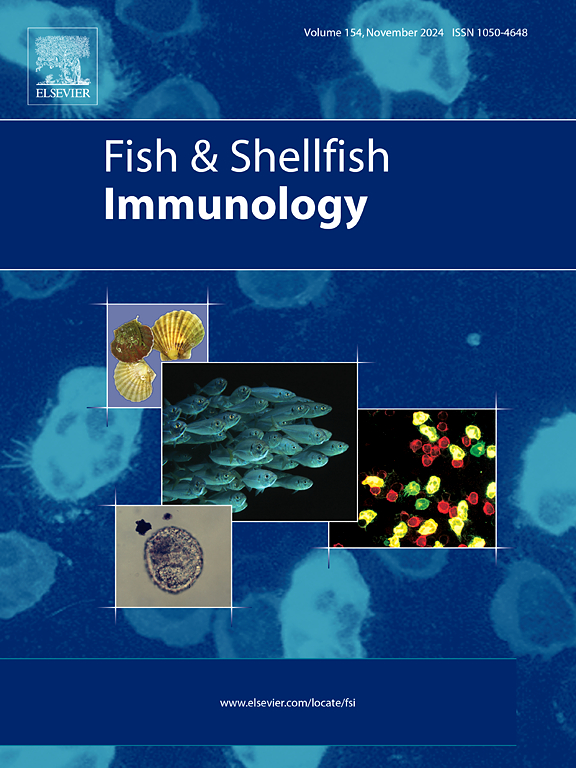白细胞高表达的e型前列腺素受体调节牡蛎长牡蛎免疫应答过程中TNF的表达。
IF 4.1
2区 农林科学
Q1 FISHERIES
引用次数: 0
摘要
前列腺素E2通过作用于四种不同的e型前列腺素受体亚型(EP1-EP4),对多种细胞具有不同的生理作用,其中EP4是已知介导哺乳动物单核细胞和巨噬细胞免疫应答的亚型之一。然而,EP4在软体动物中的确切特征和功能尚不清楚。本研究从长牡蛎中鉴定出一种EP4同源物(命名为CgEP4)。CgEP4具有7螺旋跨膜结构域,与脊椎动物同源物具有显著的同源性,并与其他软体动物的ep4聚类。CgEP4转染HEK293细胞系表达后,其激动剂PGE2处理后细胞内Ca2+浓度显著升高,cAMP浓度变化不明显。CgEP4 mRNA转录本主要在血细胞中表达,是肝胰腺的28.37倍(p < 0.05)。免疫荧光分析发现CgEP4主要表达于粒细胞亚群,CgEP4+粒细胞占总血细胞的18%。脾弧菌刺激后,血细胞中CgEP4 mRNA表达在前12 h无明显变化,在24 h显著上调,是对照组的2.7倍(p < 0.01)。体内PGE2处理后,血细胞中JNK (p-JNK)磷酸化水平显著降低,ERK (p-ERK)磷酸化水平不显著降低,是对照组的0.64倍(p < 0.05)。同时,血细胞中CgTNF-1和CgTNF-2 mRNA表达量显著下调,分别为0.06倍(p < 0.05)和0.73倍(p < 0.05)本文章由计算机程序翻译,如有差异,请以英文原文为准。
The haemocyte highly-expressed E-type prostanoid receptor regulates TNF expression during immune response of oyster Crassostrea gigas
Prostaglandin E2 imparts diverse physiological effects on multiple cells through its actions on four distinct E-type prostanoid (EP) receptor subtypes (EP1-EP4), among which the EP4 is one of subtypes known to mediate the immune response in mammalian monocytes and macrophages. However, the precise characteristics and functions of EP4 in mollusks remain unclear. In the present study, an EP4 homologue (designated as CgEP4) was identified from oyster Crassostrea gigas. CgEP4 contained a seven-helix transmembrane domain, shared significant homology with its vertebrate homologs, and clustered with EP4s from other Mollusca by phylogenetic analysis. When CgEP4 was transfected and expressed in HEK293 cell line, the concentration of intracellular Ca2+ was significantly increased after treatment with its agonist PGE2, while that of cAMP was not obviously changed. The mRNA transcripts of CgEP4 were dominantly expressed in haemocytes, which was 28.37-fold (p < 0.05) higher than that in hepatopancreas. By immunofluorescence analysis, CgEP4 was found to be mainly expressed in the agranulocyte subpopulation, and CgEP4+ agranulocyte accounted for 18 % of total haemocytes. After Vibrio splendidus stimulation, the mRNA expression of CgEP4 in haemocytes was not obviously changed at the first 12 h, then significantly up-regulated at 24 h, which was 2.7-fold (p < 0.01) of that in control group. After PGE2 treatment in vivo, the phosphorylation of JNK (p-JNK) in haemocytes, but not the phosphorylated ERK (p-ERK), was significantly decreased, which was 0.64-fold (p < 0.05) of that in control group. Simultaneously, the mRNA expression levels of CgTNF-1 and CgTNF-2 in haemocytes dramatically down-regulated, which were 0.06-fold (p < 0.05) and 0.73-fold (p < 0.05) of that in control group at 24 h. When the EP4 antagonist Grapiprant was added with PGE2 treatment in vivo, the p-JNK in haemocytes significantly increased, concomitant with the up-regulation of expressions of CgTNF-1 and CgTNF-2, which were 2.86-fold (p < 0.05) and 1.31-fold (p < 0.05) of that in control group at 24 h. Collectively, these results provides the experimental evidence of a haemocyte highly-expressed EP4 receptor CgEP4 regulating TNFs’ expression through MAPK pathway in the innate immune response in C. gigas, and it could be used as a surface marker to type and sort a subset of agranulocyte subpopulation among haemocytes.
求助全文
通过发布文献求助,成功后即可免费获取论文全文。
去求助
来源期刊

Fish & shellfish immunology
农林科学-海洋与淡水生物学
CiteScore
7.50
自引率
19.10%
发文量
750
审稿时长
68 days
期刊介绍:
Fish and Shellfish Immunology rapidly publishes high-quality, peer-refereed contributions in the expanding fields of fish and shellfish immunology. It presents studies on the basic mechanisms of both the specific and non-specific defense systems, the cells, tissues, and humoral factors involved, their dependence on environmental and intrinsic factors, response to pathogens, response to vaccination, and applied studies on the development of specific vaccines for use in the aquaculture industry.
 求助内容:
求助内容: 应助结果提醒方式:
应助结果提醒方式:


